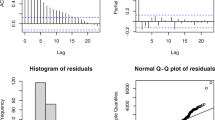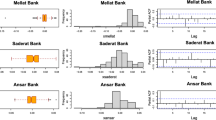Summary
In this paper we develop large sample approximations for the variances of the residuals obtained from either a least squares or rank analysis of a first order autoregressive process. The formulas are elaborate, but can easily be computed either recursively or via an object oriented language such as S-PLUS. More importantly, our findings indicate that the variances of the residuals depend on much more than just the standard deviation of the error distribution. Thus, we caution against the use of the naive standardization for time series diagnostic procedures. Furthermore, the results can be used to form studentized residuals analogous to those used in the linear regression setting. We compare these new residuals to the conditionally studentized residuals via an example and simulation study. The study reveals some minor differences between the two sets of residuals in regards to outlier detection. Based on our findings, we conclude that the classical studentized linear regression residuals, found in such packages as SAS, SPSS, and RGLM can effectively be used in an autoregressive time series context.



Similar content being viewed by others
References
Belsley, D. A., Kuh, E., & Welsch, R. E. (1980). Regression Diagnostics: Identifying Influential Data and Sources of Collinearity. New York: John Wiley and Sons.
Brockwell, P. J. & Davis, R. A. (1991). Time Series: Theory and Methods. New York: Springer-Verlag.
Cook, R. D. & Weisberg, S. (1982). Residuals and Influence in Regression. Monographs on Statistics and Applied Probability. New York: Chapman and Hall.
Faltin, F. W., Mastrangelo, C. M., Runger, G. C., & Ryan, T. P. (1997). “Considerations in the Monitoring of Autocorrelated and Independent Data”. Journal of Quality Technology, 29(2), 131–133.
Hettmansperger, T. P. & McKean, J. W. (1998). Robust Nonparametric Statistical Methods. Great Britain: Arnold.
Koul, H. L. & Saleh, A. K. M. E. (1993). “R-Estimation of the Parameters of Autoregressive [AR(p)] Models”. The Annals of Statistics, 21(1), 534–551.
Kunsch, H. (1984a). “Infinitesimal Robustness for Autoregressive Processes”. The Annals of Statistics, 12(3), 843–863.
Kunsch, H. (1984b). “Programs for Robust Estimation in Autoregressive Model Fitting”. Proceedings of the Institute of Statistical Mathematics, 32(2), 241–260. In Japanese.
Lu, C.-W. & Reynolds, Jr., M. R. (1999a). “Control Charts for Monitoring the Mean and Variance of Autocorrelated Processes”. Journal of Quality Technology, 31(3), 259–274.
Lu, C.-W. & Reynolds, Jr., M. R. (1999b). “EWMA Control Charts for Monitoring the Mean of Autocorrelated Processes”. Journal of Quality Technology, 31(2), 166–188.
McKean, J. W., Sheather, S. J., & Hettmansperger, T. P. (1990). “Regression Diagnostics for Rank-Based Methods”. The Journal of the American Statistical Association, 85, 1018–1028.
Terpstra, J. T., McKean, J. W., & Naranjo, J. D. (2000). “Highly Efficient Weighted Wilcoxon Estimates for Autoregression”. Statistics, 35, 45–80.
Wei, W. W. (1990). Time Series Analysis Univariate and Multivariate Methods. Addison-Wesley Publishing Company.
Acknowledgments
We would like to thank an anonymous referee for many helpful suggestions that led to a much improved paper.
Author information
Authors and Affiliations
A Lemma and Proofs
A Lemma and Proofs
The results of the following lemma are used in the proofs of Theorems 2.1 and 2.2.
Lemma A.1 Let \({U_i} = U\left( {{\varepsilon _i}} \right)\), \({\sigma ^2} = E\left[ {\varepsilon _1^2} \right]\), \(\sigma _x^2 = E\left[ {X_1^2} \right]\), and for s ≤ t let \(\Gamma _s^t = \sum\nolimits_{r = 0}^{t - s} {{\rho ^r}{\varepsilon _{t - r}}} \). When s > t let \(\Gamma _s^t = 0\), Furthermore, for some 0 ≤ r ≤ 2, let
Then, model assumptions (1)-(2) imply the following.
-
1.
For \(s < t,{X_t} = {\rho ^{t - s}}{X_s} + {\rho ^{t - s - 1}}{\varepsilon _{s + 1}} + \Gamma _{s + 2}^t\)
-
2.
\(E\left[ {\Gamma _s^t} \right] = 0\)
-
3.
\(V\left[ {\Gamma _s^t} \right] = \sigma _x^2\left( {1 - {\rho ^{2\left( {t - s + 1} \right)}}} \right)\)
-
4.
\(E\left[ {X_1^2} \right] = \sigma _x^2 = {\sigma ^2}{\left( {1 - {\rho ^2}} \right)^{ - 1}}\)
-
5.
\(E\left[ {X_1^3} \right] = E\left[ {\varepsilon _1^3} \right]{\left( {1 - {\rho ^3}} \right)^{ - 1}}\)
-
6.
\(E\left[ {X_1^4} \right] = \left( {\left( {{{6{\rho ^2}} \over {1 - {\rho ^2}}}} \right){\sigma ^4} + E\left[ {\varepsilon _1^4} \right]} \right){\left( {1 - {\rho ^4}} \right)^{ - 1}}\)
-
7.
For \(\begin{array}{*{20}c}{\quad \quad 1 \le i \le k - 1,E\left[ {X_{i - 1}^r{U_i}{X_{k - 1}}} \right] = {\rho ^{k - i}}E\left[ {X_1^{r + 1}} \right]E\left[ {{U_1}} \right] + } \\ {{\rho ^{k - i - 1}}E\left[ {X_1^r} \right]E\left[ {{U_1}{\varepsilon _1}} \right]} \\ \end{array} \)
-
8.
For \(1 \le i \le k - 1,E\left[ {X_{i - 1}^r{U_i}X_{k - 1}^2} \right] = \sigma _x^2E\left[ {X_1^r} \right]E\left[ {{U_1}} \right] + {\rho ^{2(k - i)}}{K_1}\)
-
9.
For \(k + 1 \le i \le n,E\left[ {X_{k - 1}^r{X_{i - 1}}{U_i}} \right] = {\rho ^{i - k}}E\left[ {X_1^{r + 1}} \right]E\left[ {{U_1}} \right]\)
-
10.
For \(k + 1 \le i \le n,E\left[ {X_{k - 1}^rX_{i - 1}^2{U_i}} \right] = \sigma _x^2E\left[ {X_1^r} \right]E\left[ {{U_1}} \right] + {\rho ^{2(i - k)}}{K_2}\)
-
11.
For \(\begin{array}{*{20}c}{\quad \quad i + 1 \le j \le k - 1{\rm{ }}and{\rm{ }}E\left[ {{U_1}} \right] = 0,E\left[ {{X_{i - 1}}{U_i}{X_{j - 1}}{U_j}X_{k - 1}^2} \right] = } \\ {4{\rho ^{2(k - i)}}{\rho ^{ - 2}}\sigma _x^2{E^2}\left[ {{U_1}{\varepsilon _1}} \right]} \\ \end{array} \)
Proof of Lemma A.1. The proof of part 1 follows by exploiting the iterative nature of the AR(1) process. The proof of part 2 follows directly from the fact that E [ε1] = 0. The proof of part 3 follows from the independence of the errors, the fact that E [ε1] = 0, and the formula for a finite sum of a geometric series. Parts 4-6 can be proved be letting \({X_1} = \rho {X_0} + {\varepsilon _1}\), expanding the associated polynomial, applying the expectation operator, and then solving for the corresponding expectation. The proofs for the remaining results are similar in nature. Thus, for the sake of brevity, we only present the proof for part 10. To begin, note that the independence of Ui and (Xk−1, Xi−1) implies that \(E\left[ {X_{k - 1}^rX_{i - 1}^2{U_i}} \right] = E\left[ {X_{k - 1}^rX_{i - 1}^2} \right]E\left[ {{U_i}} \right]\). Now let \({X_{i - 1}} = {\rho ^{i - k}}{X_{k - 1}} + {\rho ^{i - k - 1}}{\varepsilon _k} + \Gamma _{k + 1}^{i - 1}\), square it, and write \(E\left[ {X_{k - 1}^rX_{i - 1}^2} \right]\)as a sum of six terms as follows
Part 2 of the lemma and the fact that E [ε1] = 0 imply that the last three terms are zero. The result now follows from part 3 and direct algebra. □
Proof of Theorem 2.1. Consider the expectation of \({\hat \varepsilon _k}\left( {LS} \right)\). Since E [ε1] = 0 it follows from (8) that
Since εk is independent of Xk−1 and E [ε1] = 0 it follows that \(E\left[ {X_{k - 1}^2{\varepsilon _k}} \right] = 0\). Furthermore, parts 7 and 9 of Lemma A.l (with r = 1 and U(εi) = εi) imply that the expectations in the first and third terms of (18) are zero. Thus, \(E\left[ {{{\hat \varepsilon }_k}\left( {LS} \right)} \right] \buildrel\textstyle.\over= 0\). Therefore, we need only consider \(E\left[ {\hat \varepsilon _k^2\left( {LS} \right)} \right]\) in order to prove the theorem. Direct algebra can be used to show the following
Consider the expectation in E1 first. For i ≠ k either εi or εk is independent of the remaining terms. This implies that these n − 1 expectations are zero since E[ε1] = 0. Hence
Next, rewrite E21 as follows
Part 8 of Lemma A.1 (with r = 2 and \(\left. {U\left( {{\varepsilon _i}} \right) = \varepsilon _i^2} \right)\) can be used to calculate the expectation in the first term of E21. That is
The second term in E21 is \(\left( {1/n} \right)E\left[ {X_1^4} \right]{\sigma ^2}\). Finally, part 10 of Lemma A.l (with r = 2 and \(U\left( {{\varepsilon _i}} \right) = \varepsilon _i^2\)) can be used to calculate the expectation in the last term of E21. That is
It follows from (20), (21), and the formula for a finite sum of a geometric series that
Lastly, consider E22 and note that there are basically five cases: k < i < j, k = i < j, i < k < j, i < j = k, and i < j < k. For the first four cases note that εj is independent from the remaining terms given in the corresponding expectation. Since E[ε1] = 0, this implies that E22 = 0 for the first four cases. For the last case use part 11 of Lemma A.l (with U(εi) = εi) to show the following
Combining (19), (22), and (23) along with the expectations given in parts 4-6 of Lemma A.l completes the proof. □
Rights and permissions
About this article
Cite this article
Terpstra, J.T., McKean, J.W. & Anderson, K. Studentized Autoregressive Time Series Residuals. Computational Statistics 18, 123–141 (2003). https://doi.org/10.1007/s001800300135
Published:
Issue Date:
DOI: https://doi.org/10.1007/s001800300135




